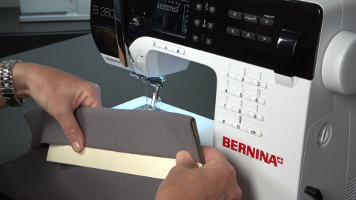

I analysed 12 UK overlockers with air threading. With these machines, you press a button and they thread the loopers for you with a whoosh of air. Today we’re looking at the best overlock machines with automatic air threading. This is part 2 of my ‘ best overlockers’ series. The serger folds the edge of the fabric, then wraps it in threads.Heads up: This post includes affiliate links like Amazon ones, so I earn from qualifying purchases (at no cost to you). This is a decorative way to finish the edge of 1 layer of fabric. It’s tricky to sew and uses a lot more thread than a sewing machine. It’s included with many sergers, but not all.


Note: no settings for knit fabrics were in my manual.
#Blind hem trial#
However, this was the best sample I had after a lot of trial and error. Not pretty! The yellow stitches should be even. So it’s not a completely weak stitch.īlind hem stitch The blind hem on a woven fabric. I gave my flatlock sample (pictured above) a good tug and was surprised it could handle it. According to manufacturer Pfaff, it’s more of a decorative stitch.
#Blind hem skin#
You don’t want a seam allowance rubbing against your skin during exercise. This joins 2 pieces of fabric without creating a seam allowance that sticks out. Here 2 pieces of white cotton were joined with a flat seam. Join the Email List 🙂** Mock flatlock stitch The front and back of a flatlock stitch on woven fabric. It tends to have a less “full” look, so you’ll get more gaps between each stitch.įor this reason, if you’re working with a fabric that frays a lot, I would choose the rolled hem over the narrow hem.Use it to finish the edges of ruffles, napkins, and scarves.Like the rolled hem, this is used to stop the raw edges of one layer of fabric fraying.It also has more gaps between each stitch. Like the rolled hem, the serger folds the edge of the fabric and wraps it in stitches.Ī narrow hem has a “line” running along the edge of the fabric (where the blue and red threads meet). Because the stitches are so close together, it takes longer to sew.It uses a lot of thread, so it’s bulky.This is a beautiful way to finish the edge of a single layer of fabric.Finish the hem of a bridesmaid/prom dress made from chiffon or tulle.This stitch looks really “full”, which is beautiful. It folds the edge of the fabric under, then wraps it in threads.
#Blind hem free#
**I Find the Best Free Sewing Patterns and Share Them Every Thursday. You normally have to buy a more expensive machine for it. I rarely see budget sergers that can do 2 thread stitches.This isn’t normally strong enough to create a seam.It uses fewer threads, making it a lighter and finer stitch. This is a nice way to finish lightweight fabrics.If you’re making an item that won’t be put under much stress, like a loose-fitting t-shirt, you can use a 3 thread overlock to create seams too.When you’ve already made a line of stitching on your sewing machine, you don’t need a strong overlock stitch. Use 3 threads when you just want to finish the raw edges of a seam.We don’t want the loops hanging off the edge. Because it uses more threads, it creates a bulkier seam.ģ thread overlock stitch Note: the looper threads (red & blue) should be tighter here.This means you’re less likely to get a hole in your finished project. The 4th thread acts as a “back-up” line of stitching.Use 4 threads when you need a strong seam.Only mid-range and high-end sergers can do a 2 thread overlock. You’ll often see this stitch in shop-bought clothes and textiles.Īll sergers can do 3 or 4 thread overlock stitches.It finishes the raw edge of fabric to stop fraying, so your finished item will last longer.An overlock stitch can stretch! So when you’re sewing knit fabrics, your overlocked seam won’t break when stretched.It can be used for knits (stretchy fabric) and wovens (non-stretchy fabric).It joins 2+ pieces of fabric together to create a seam.This is the main stitch you buy a serger for.
#Blind hem how to#
Related article: How to Choose a Serger or Overlocker: 21 Factors to Consider (+ Checklist)


 0 kommentar(er)
0 kommentar(er)
